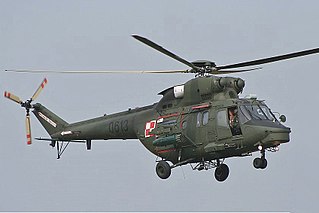
The Mil Mi-2 is a small, three rotor blade Soviet-designed multi-purpose helicopter developed by the Mil Moscow Helicopter Plant, designed in the early 1960s and produced exclusively by WSK "PZL-Świdnik" in Poland. Nearly 5500 were made by the time production stopped in 1999, and it remains in service globally.

The Mil Mi-34 is a light helicopter designed by the Mil Moscow Helicopter Plant in either a two or four seat configuration for utility and training. It was first flown on 17 November 1986 and introduced at the Paris Air Show in 1987. The Mi-34 entered production in 1993, and is capable of performing aerobatic manoeuvres, including rolls and loops.

The Mil Mi-6, given the article number izdeliye 50 and company designation V-6, is a Soviet/Russian heavy transport helicopter that was designed by the Mil design bureau. It was built in large numbers for both military and civil use and was the largest helicopter in production until the Mil Mi-26 was put in production in 1980.

The Mil Mi-1 was a Soviet three- or four-seat light utility helicopter. It was the first Soviet helicopter to enter serial production. It is powered by one 575 hp (429 kW) Ivchenko AI-26V radial piston engine. It entered service in 1950 and was first seen on the 1951 Soviet Aviation Day, Tushino and was produced for 16 years. More than 1,000 were built in the USSR and 1,594 in Poland, as SM-1.

The PZL SW-4 Puszczyk is a Polish light single-engine multipurpose helicopter manufactured by PZL-Świdnik. Following a protracted development, the SW-4 entered service in 2002, the primary operator of the type has been the Polish Armed Forces. The SW-4 was further developed by PZL-Świdnik and corporate parent AgustaWestland into an optionally piloted vehicle, the SW-4 Solo. From 2016 onwards, the type has been marketed to civil operators as the AW009, while the SW-4 designation is used for the military market.

The PZL W-3 Sokół is a medium-size, twin-engine, multipurpose helicopter developed and manufactured by Polish helicopter company PZL-Świdnik, now owned by Leonardo. It was the first helicopter entirely designed and produced in Poland.

The PZL-Mielec M-20 Mewa is a licence-built version of the Piper PA-34 Seneca II manufactured in Poland by WSK PZL Mielec in a limited series from the 1980s.

The PZL-101 Gawron (rook) is a Polish agricultural and utility aircraft designed and built by WSK-Okęcie.

PZL.19 was a Polish sports aircraft built in 1932 in the PZL works. Ordered by the Ministry of Communications, it was specifically designed for the upcoming Challenge 1932 contest held that year in Germany.

PZL.26 was a Polish sports plane built in 1934 by the Państwowe Zakłady Lotnicze. Ordered by the Ministry of Defence, it was specifically designed for the upcoming Challenge 1934 International Touring Aircraft Contest.

The PZL-105 Flaming (flamingo) is a Polish short-takeoff-and-landing (STOL) utility aircraft designed by PZL "Warszawa-Okęcie". It remained a prototype.

The PZL S-4 Kania 2 was a Polish trainer and glider towing aircraft of the 1950s, not built in series. The first prototype was designated S-3 Kania. There is also a helicopter named PZL Kania.

The BŻ-4 Żuk, formerly known as GIL-4, was a Polish four-seat light helicopter built in the 1950s. Although it pioneered a novel rotor and transmission system, it never entered series production.
The Manzolini Libellula was a 1950s Italian co-axial twin-rotor helicopter designed by Ettore Manzolini. "Libellula" is the Italian word for "Dragonfly".

The PZL-102 Kos (blackbird) is a Polish two-seat touring and training monoplane designed and built by PZL.

The PZL SM-2 was a Polish light utility helicopter, enlarged version of license-built Mil Mi-1, developed and produced by WSK PZL-Świdnik. It was also known as the WSK SM-2.

The Silvercraft SH-4 is an Italian three-seater light helicopter designed and built by Silvercraft SpA.
The Spitfire Mark I was a utility helicopter built in the United States in the late 1970s and intended for series production. In essence, the Mark I was an Enstrom F-28 that was modified to use an Allison 250 turboshaft engine and geared transmission in place of the original piston engine and system of vee belts. The resulting powerplant installation was lighter and more compact, which allowed for additional cargo or fuel.
The Spitfire Mark II, later given the name Tigershark, was a utility helicopter built in the United States in the late 1970s and intended for series production. It was a further evolution of the Spitfire Mark I design, a turbine-powered conversion of the Enstrom F-28. Although airframe changes on the Mark I had been minimal, the Mark II had a substantially redesigned fuselage that rearranged the F-28's 2+2 seating to move the pilot's seat forward in the nose by itself and add a bench seat for three passengers abreast behind it. The leftmost seat on the bench could be fitted with dual controls. The fuselage was lengthened, and the powerplant installation was mounted well to the rear. The Mark II still used the dynamic components of the F-28, plus some of its airframe.

The PZL SM-4 Łątka was a prototype three-seat helicopter of the 1960s, developed by WSK PZL-Świdnik in Poland. Of largely conventional design and construction, a single prototype was built, but was not flown as a result of engine problems.

















